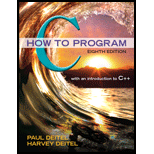
Concept explainers
define keyword is used to define macros
An object-like macros is defined i.e.
#define pi 3.14
A function-like macros is defined i.e.
#define VOL( x ) ( 4.0 / 3 ) * pi * ( x * x * x )
Variable r is declared to store the value of radius.
printf (): used to print the data onto output screen.
Program Description: Purpose of the program is to define macros tofind the volume of sphere for radius values ranging from 1 to 10 in tabular form.
Explanation of Solution
Program: Following is C++ program that defines macros to find the volume of sphere for radius values ranging from 1 to 10.
#include<stdio.h>//header file for input output
//defining macros
#define pi 3.14
#define VOL( x ) ( 4.0 / 3 ) * pi * ( x * x * x )
//start of main
intmain()
{
//defining variable for storing value of radius
int radius;
//tabular reprsentation of data
printf( "Radius\tVolume of sphere\n" );
printf( "\n" );
//for loop to iterate over the value of radius ranging from 1 to 10
for (radius = 1; radius < 11; radius++ )
{
printf( "%d\t%f\n", radius, VOL( radius ) );
}
}//end of main
Explanation:
The given C++ program calculates the volume of sphere.
For declaring the macros statements the define keyword is used for VOL(x) and pi.
Then using the for loop to iterate over the radius variable from 1 to 10 and to print one by one via “\n”. The “\t” is used to print six spaces between the radius and their volume.
Sample Output:

Want to see more full solutions like this?
Chapter 13 Solutions
C How to Program (8th Edition)
- using r language Obtain a bootstrap t confidence interval estimate for the correlation statistic in Example 8.2 (law data in bootstrap).arrow_forwardusing r language Compute a jackknife estimate of the bias and the standard error of the correlation statistic in Example 8.2.arrow_forwardusing r languagearrow_forward
- using r languagearrow_forwardThe assignment here is to write an app using a database named CIT321 with a collection named students; we will provide a CSV file of the data. You need to use Vue.js to display 2 pages. You should know that this assignment is similar, all too similar in fact, to the cars4sale2 example in the lecture notes for Vue.js 2. You should study that program first. If you figure out cars4sale2, then program 6 will be extremely straightforward. It is not my intent do drop a ton of new material here in the last few days of class. The database contains 51 documents. The first rows of the CSV file look like this: sid last_name 1 Astaire first_name Humphrey CIT major hrs_attempted gpa_points 10 34 2 Bacall Katharine EET 40 128 3 Bergman Bette EET 42 97 4 Bogart Cary CIT 11 33 5 Brando James WEB 59 183 6 Cagney Marlon CIT 13 40 GPA is calculated as gpa_points divided by hrs_attempted. GPA points would have been arrived at by adding 4 points for each credit hour of A, 3 points for each credit hour of…arrow_forwardI need help to solve the following case, thank youarrow_forward
- You will write a program that allows the user to keep track of college locations and details about each location. To begin you will create a College python class that keeps track of the csollege's unique id number, name, address, phone number, maximum students, and average tuition cost. Once you have built the College class, you will write a program that stores College objects in a dictionary while using the College's unique id number as the key. The program should display a menu in this order that lets the user: 1) Add a new College 2) Look up a College 4) Delete an existing College 5) Change an existing College's name, address, phone number, maximum guests, and average tuition cost. 6) Exit the programarrow_forwardShow all the workarrow_forwardConstruct a frequency polygon density estimate for the sample in Question 1, using bin width determined by Sturges’ Rule.arrow_forward
 C++ Programming: From Problem Analysis to Program...Computer ScienceISBN:9781337102087Author:D. S. MalikPublisher:Cengage Learning
C++ Programming: From Problem Analysis to Program...Computer ScienceISBN:9781337102087Author:D. S. MalikPublisher:Cengage Learning C++ for Engineers and ScientistsComputer ScienceISBN:9781133187844Author:Bronson, Gary J.Publisher:Course Technology Ptr
C++ for Engineers and ScientistsComputer ScienceISBN:9781133187844Author:Bronson, Gary J.Publisher:Course Technology Ptr Microsoft Visual C#Computer ScienceISBN:9781337102100Author:Joyce, Farrell.Publisher:Cengage Learning,
Microsoft Visual C#Computer ScienceISBN:9781337102100Author:Joyce, Farrell.Publisher:Cengage Learning,


